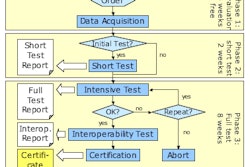Decades before "Sesame Street" hit the airwaves I learned to read with four very good literary friends: Dick, Jane, Sally, and Spot. One writer summed it up nicely: "Browsing through the book of wrinkled tattered pages I could see the watercolor pictures of Sally in her yellow print dress putting on Father's rubbers over her white baby shoes. Dick, her brother, in his striped polo shirt and brown pants pulling little Sally in the red wagon, big sister Jane in her red flowered dress, Spot, their black and white dog and Father and Mother."
So many others of my generation also learned to read with Dick and Jane. That is why I never cease to be amazed that so many contracts get signed without even being read, let alone understood.
If anyone ever read three-quarters of the PACS contracts being proffered today, there is no way on earth they would sign them. One vendor in particular even threatens to penalize you if you let someone else even read their contract, let alone comment on it. Here is the actual contract language, with the names blanked out to protect the offending party:
By its receipt of this quote, Customer acknowledges and agrees that the pricing and product configuration contained herein are Confidential in nature, and, as such cannot be shared with any other party, including, but not limited to, any affiliate of Customer, without (vendor's) prior written consent. In addition to (vendor) pursuing any other remedies available to it in law or equity, in the event Customer violates the terms of this provision, this quote shall immediately terminate or, if Customer has entered into an Agreement with (vendor) for the purchase of the above Products and/or Services, the foregoing pricing shall be null and void and Customer shall immediately pay an amount equal to the list price of the Products and/or Services less any amounts paid (or currently owed) to (vendor) for such Products and/or Services."
Who in their right mind would sign an agreement like that, even if the nuances contained therein are less than subtle? Only about 250 or so hospitals last year alone.
Now I can understand why a vendor would want to protect pricing interests, but let's face it: as long as people are people and companies can make money by offering subscription services offering to "level (the) playing field for hospitals and medical technology vendors, empowering … members to make sound technology and financial decisions," prices are going to be shared regardless of what any agreement says. Wanting to keep a configuration confidential defies logic, though.
This same vendor also makes you deal with nearly two full pages of "it never was, never is, and never will be our fault" indemnification clauses, an incredibly confusing licensing arrangement that combines individual and site licenses in the same contract, and my all-time favorite, the "we'll raise the rates to whatever we want to" clause that reads:
Except as noted below, all monthly, annual or other recurring Fees specified by this Agreement shall be subject to increase in an amount to be determined by (vendor) during the period between the date of the Order and the invoice date. In the case of Maintenance Services, Fees will be adjusted annually at a rate to be determined by (the vendor).
Their return policy is even more special:
(Vendor) shall not be required to accept return of any Product properly delivered pursuant to any Order. In the event (Vendor), in its sole discretion, accepts return of any Product, and the Product is returned in its original condition, (Vendor) shall credit Customer for the purchase price (excluding shipping and related delivery charges) net of a restocking and write-down fee of 20% of the net value of the Product so returned. Customer will not incur a restocking and write-down fee in the event the Product is returned to (Vendor) for nonperformance or failure to conform to the warranty extended by Section (XXX) of this Agreement. Nothing in this Section (XXX) shall be construed to require (Vendor) to refund or credit any amounts Customer pays for Professional Services.
I don't want to pick on any one particular vendor, because nearly all vendors have things in their contracts that defy logic. Even though this vendor has unquestionably one of the worst contracts I've ever seen, believe it or not I've seen worse clauses.
Uptime guarantees
While so many PACS vendors make a big deal about their uptime guarantees, very few are willing to accept any penalties for failure to meet the uptime or response time guarantees. If they do, they give new meaning to the words "force majeure" and couch any penalties they accept with enough exemptions to cover half the distance between here and the moon. This is one of the primary reasons why I tell customers to focus on service response time, not uptime.
One vendor offered a 99% uptime on a key PACS component -- not great by any means, but acceptable given the redundancy since several of these units were being purchased. The kicker, though, was the vendor's uptime guarantee language. The vendor offered this:
The penalty for failure to meet this guarantee is an extension of the warranty/contract or discount from contract for every percent below uptime guarantee at the same percent in time or dollars to a maximum of 15%.
Sounds pretty fair doesn't it? Now, reread it more closely, focusing on the words "discount from contract" and "at the same percent in time and dollars."
For the sake of discussion, let's assume that service on a unit is $7,500 per year, 15% of list price, on a device that lists at $50,000. The value of each 1% of uptime is then worth $75. That sounds fair until you realize that 1% downtime equals 7.4 hours of allowable downtime when calculated on a 24/7 basis. This equals roughly $10 per hour of vendor "penalty." Keep in mind the first 1% (7.4 hours) also doesn't count, bringing the first 15 hours down to about $5 an hour.
While uptime is calculated on a 24/7 basis, warranty and covered service is only rendered between 9 a.m. and 6 p.m., Monday through Friday. If you want service done after these hours, according to their contract, it will cost you, at a minimum, two hours of travel and four hours onsite service or roughly $1,000, at prevailing time-and-materials rates. Depending on how far the service rep is from the facility, this may be the charge to simply say "hello."
Less than punitive penalties
As the infomercials always like to say, "But wait, there's more!!!" Most vendors' measurement periods, including this particular vendor, are annualized on a cumulative basis instead of on a monthly nonrecurring basis as it should be.
This means that the penalty phase may not even kick in until you have reached almost 89 hours per unit (the maximum allowable downtime annualized). Go three months without any downtime at all and you can have almost 30 hours where the system can be down continuously without penalty (22.2 hours plus 7.4 hours for the 1% allowable downtime).
Go six months and this increases to 52 hours where the system can be down continuously without penalty (44.4 hours plus 7.4 hours for 1% allowable downtime). In the three-month scenario, the vendor may or may not incur a penalty at all if a unit is down over the weekend; it all depends on how you and the vendor interpret the contract.
Contractually, it also can't be fixed without the facility incurring an additional charge so.... And the penalty in this situation? Depending on the total number of hours the system is down, generally it's less than $300 that you can use against future service costs.
This is part of my ongoing "We'll give you more lousy service to make up for the lousy service we already gave you" argument I have relating to accepting service credits as a vendor's "penalty."
It gets even better though. If, God forbid, a unit is down four days or more waiting for a part to ship or for a technical specialist to show up, you're out of luck because the annual "penalties" cap out at a whopping $1,125 per year. When you consider what also isn't covered, you'll see the "deal" on the table really isn't that great a deal after all.
So what's the vendor response to all this? "We've sold over 400 of these units last year alone and never had a single customer question us on this!!!" In these situations, I'm not sure if I want to laugh or cry. Because 400 people can't or don't read the fine print, does that make it right? Apparently so.
Trusting your vendor
More often than not, most customers are simply willing to forego even acknowledging a vendor's contractual shortcomings and will sign the contract "as is," taking a "trust me" approach to the client/vendor relationship.
I both love and hate seeing that. On the plus side, it provided my company with a plethora of business last year when the vendor used the contract terms and conditions as their fallback position. On the minus side, it reaffirms the point that many vendors can't be trusted at their word, requiring someone with a sense of fairness to help the client work through these issues.
In the vast majority of situations, most facilities also haven't a clue what they contractually agreed to. What's even worse, contract reviews undertaken by a hospital's legal department afford them with little, if any, protection.
Most legal counsels, including third-party counsels who claim to be experts in the area and charge a fortune to add worthless PACS legalese to a contract and rack up billable hours arguing minutiae, really don't know the subtleties and nuances that make up the operation of a PACS.
Unless these issues get addressed contractually, the end user is afforded little protection. Ideally, a vendor's contract should address all issues. The reality is, though, that very few do, and when they do, it's lopsided in the vendor's favor.
The way vendors define uptime is another example. Most use a fairly complex formula to determine uptime so that it is in their favor. What's even more interesting is how vendors determine what is and isn't a down system. One major PACS vendor uses language that says, in part, "... if 70% of the workstations are operative, then the PAC system shall be considered operative."
Take a facility that employs four radiologists reading full-time. To have a vendor feel a workstation (and the associated radiologist with it) can be inoperative, yet still have the "system" considered "up" defies logic. I'm sure the three remaining radiologists trying to take up their counterpart's workload would feel otherwise, as would the radiologist who gets to play golf that day, yet that is the "logic" behind many contracts and associated penalties therein.
The "S" in PACS stands for system, and, as such, the entire system needs to be treated as that, without having individual components addressed separately. A few select vendors actually do treat PACS as the system it really is, but the vast majority still treats the system as individual components with separate definitions of uptime/downtime by component unless otherwise requested.
Warranty length
The last area we'll examine in this article is warranty length. With few exceptions, almost all vendors offer a one-year warranty. When the warranty actually starts, though, is typically found in the fine print.
More than half of all PACS warranties start when the contract is signed. The delay between contract initiation and product shipment, let alone completion of implementation, can easily range from three to six months, as noted in a recent AuntMinnie.com article titled "PACS installations stuck in traffic jam."
When you figure that service contract costs average 16% of list price per year (18% to 22% of net depending on discounting), this can easily add 9% to 11% to the net purchase price. This can add $45,000 to $55,000 or more on a $1 million sale.
About 25% of warranties start once the system software has been installed. This is better, but still not ideal. Just because the system software is installed does not necessarily mean the system works as it should. That is the purpose of defining clinical acceptance -- a statement that the system has been tested and works as intended. The best warranties start after the customer has clinically accepted the system.
The comments herein aren't restricted just to PACS, although PACS are much more complex than other modalities because of the number of devices and other clinical systems they are interfaced to. I've reviewed CT and nuclear medicine contracts for clients recently and the amount of information that is not addressed contractually is equally amazing. Sadly, what isn't addressed is probably more important than what is.
There is no reason why contracts need to be so complex, yet until they get as simple as "See Spot Run. Run, Spot, Run!" facilities need to stop being Dicks and Janes about it all and learn to read and address the fine print.
By Michael J. Cannavo
AuntMinnie.com contributing writer
March 12, 2007
Michael J. Cannavo is a leading PACS consultant and has authored nearly 300 articles on PACS technology in the past 15 years. He can be reached via e-mail at [email protected].
The comments and observations expressed herein do not necessarily reflect the opinions of AuntMinnie.com, nor should they be construed as an endorsement or admonishment of any particular vendor, analyst, industry consultant, or consulting group. Rather, they should be taken as the personal observations of a guy who has, by his own account, been in this industry way too long.
Related Reading
The 2006 PACSman Awards: Of Chiclets and cappuccino, November 29, 2006
Part XIII: Exploring PACS Secrets -- Penny-wise, pound-foolish, October 16, 2006
Part XII: Exploring PACS Secrets -- PACS and marriage, August 15, 2006
Part XI: Exploring PACS Secrets -- Stop the insanity, May 29, 2006
Part X: Exploring PACS Secrets -- Excuses, excuses, May 19, 2006
Copyright © 2007 AuntMinnie.com



















